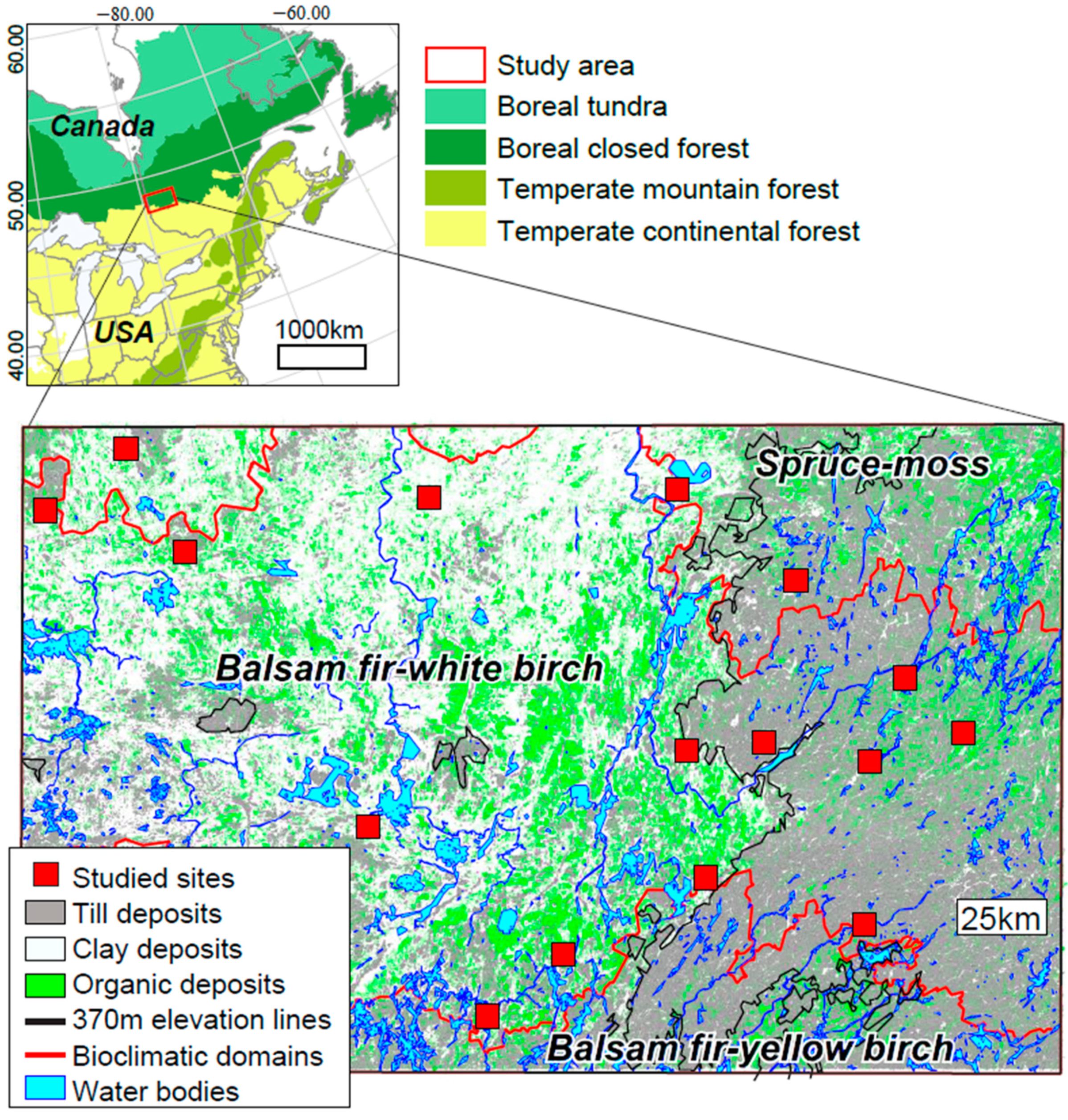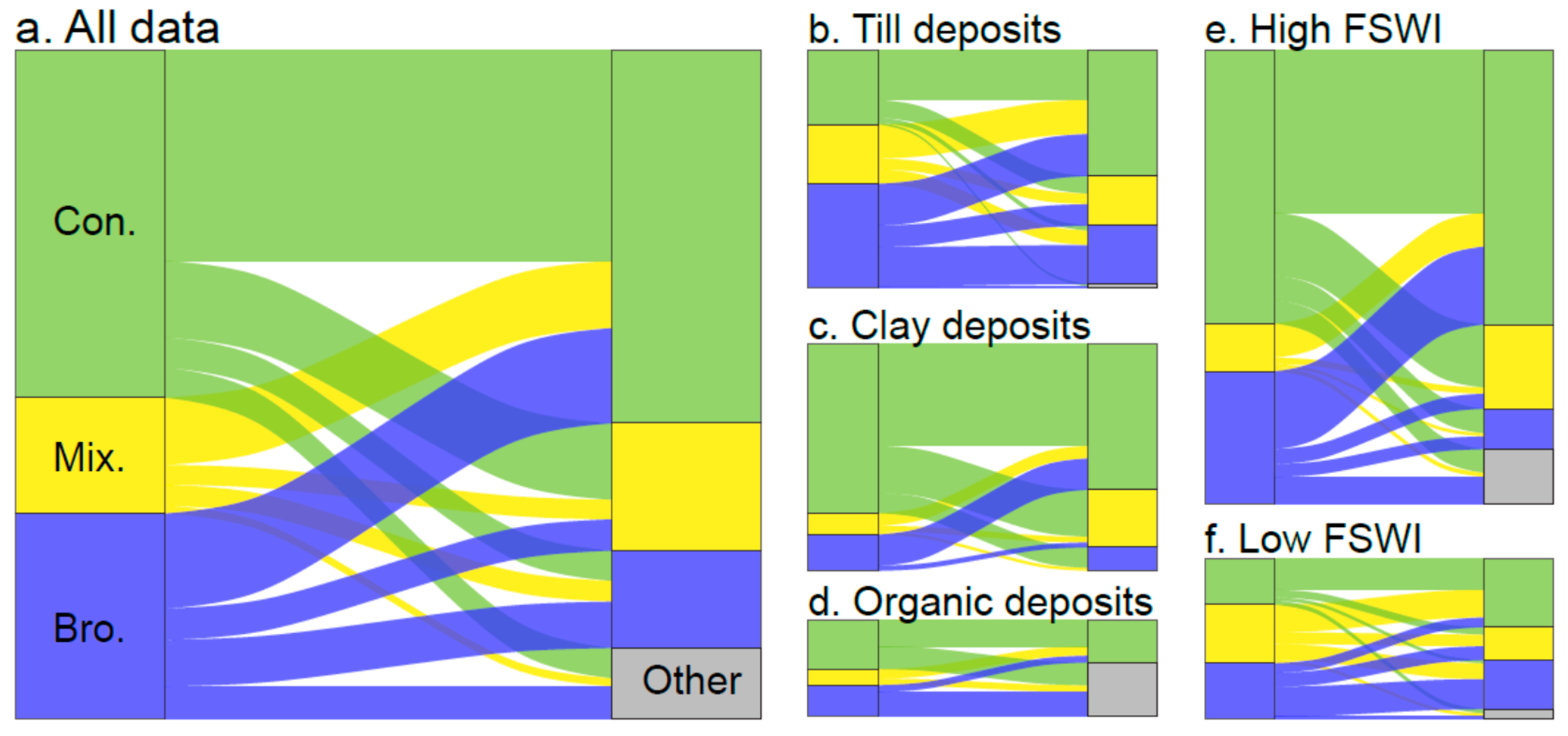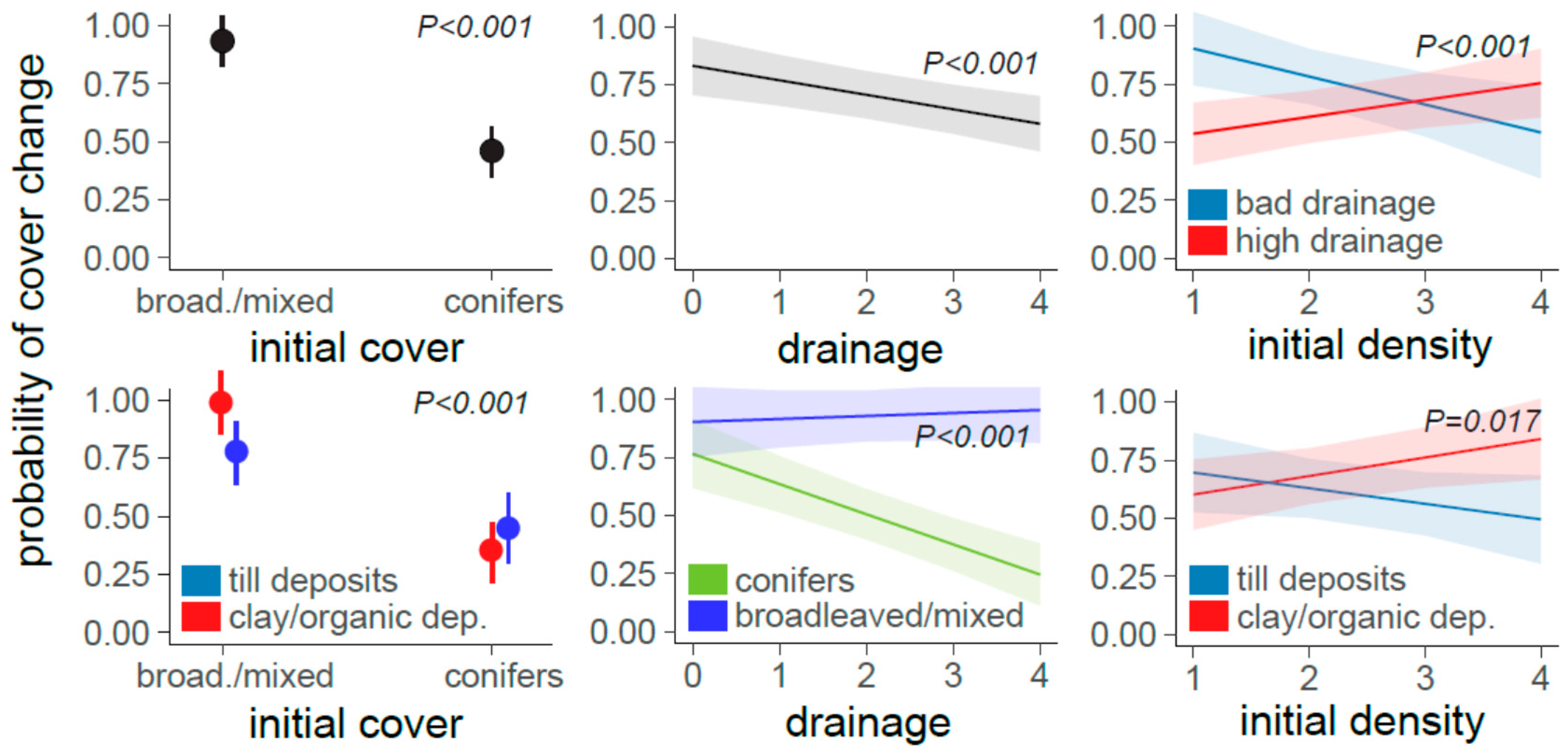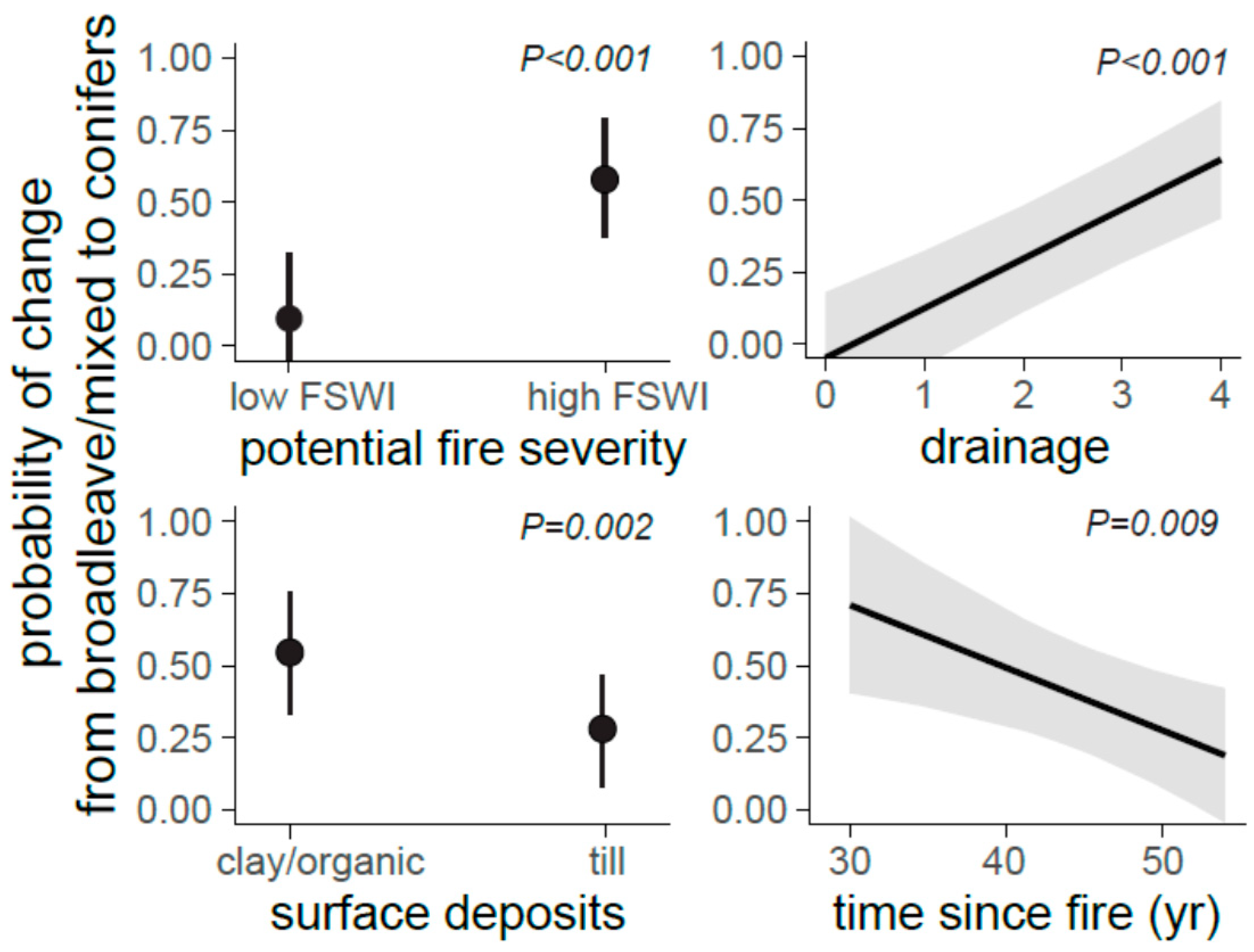How Initial Forest Cover, Site Characteristics and Fire Severity Drive the Dynamics of the Southern Boreal Forest
Abstract
1. Introduction
2. Materials and Methods
2.1. Study Area
2.2. Forest Covers Change and Environmental Data
2.3. Statistical Analyses
3. Results
4. Discussion
5. Conclusions
Author Contributions
Funding
Acknowledgments
Conflicts of Interest
References
- Bond, W.J.; Woodward, F.I.; Midgley, G.F. The global distribution of ecosystems in a world without fire. New Phytol. 2004, 165, 525–538. [Google Scholar] [CrossRef] [PubMed]
- Bergeron, Y. Species and stand dynamics in the mixed woods of Quebec’s southern boreal forest. Ecology 2000, 81, 1500–1516. [Google Scholar] [CrossRef]
- Cyr, D.; Gauthier, S.; Bergeron, Y. The influence of landscape-level heterogeneity in fire frequency on canopy composition in the boreal forest of eastern Canada. J. Veg. Sci. 2012, 23, 140–150. [Google Scholar] [CrossRef]
- Gennaretti, F.; Arseneault, D.; Bégin, Y. Millennial disturbance-driven forest stand dynamics in the Eastern Canadian taiga reconstructed from subfossil logs. J. Ecol. 2014, 102, 1612–1622. [Google Scholar] [CrossRef]
- Boucher, Y.; Auger, I.; Noël, J.; Grondin, P.; Arseneault, D. Fire is a stronger driver of forest composition than logging in the boreal forest of eastern Canada. J. Veg. Sci. 2016, 28, 57–68. [Google Scholar] [CrossRef]
- Kelley, D.I.; Bistinas, I.; Whitley, R.; Burton, C.; Marthews, T.R.; Dong, N. How contemporary bioclimatic and human controls change global fire regimes. Nat. Clim. Chang. 2019, 9, 690–696. [Google Scholar] [CrossRef]
- Westerling, A.L.; Hidalgo, H.G.; Cayan, D.R.; Swetnam, T.W. Warming and Earlier Spring Increase Western U.S. Forest Wildfire Activity. Science 2006, 313, 940–943. [Google Scholar] [CrossRef]
- Westerling, A.L.; Turner, M.G.; Smithwick, E.A.H.; Romme, W.H.; Ryan, M.G. Continued warming could transform Greater Yellowstone fire regimes by mid-21st century. Proc. Natl. Acad. Sci. USA 2011, 108, 13165–13170. [Google Scholar] [CrossRef]
- Flannigan, M.D.; Krawchuk, M.A.; de Groot, W.J.; Wotton, B.M.; Gowman, L.M. Implications of changing climate for global wildland fire. Int. J. Wildland Fire 2009, 18, 483. [Google Scholar] [CrossRef]
- Flannigan, M.; Stocks, B.; Turetsky, M.; Wotton, M. Impacts of climate change on fire activity and fire management in the circumboreal forest. Glob. Chang. Biol. 2009, 15, 549–560. [Google Scholar] [CrossRef]
- Ali, A.A.; Blarquez, O.; Girardin, M.P.; Hely, C.; Tinquaut, F.; El Guellab, A.; Valsecchi, V.; Terrier, A.; Bremond, L.; Genries, A.; et al. Control of the multimillennial wildfire size in boreal North America by spring climatic conditions. Proc. Natl. Acad. Sci. USA 2012, 109, 20966–20970. [Google Scholar] [CrossRef] [PubMed]
- Rudolf, T.D.; Laidly, P.R. Pinus banksiana Lamb. Jack Pine. In Silvics of North America; Burns, R.M., Honkala, B.H., Eds.; USDA Forest Service: Washington, DC, USA, 1990; ISBN 0-16-027145-2. [Google Scholar]
- Greene, D.F.; Zasada, J.C.; Sirois, L.; Kneeshaw, D.; Morin, H.; Charron, I.; Simard, M.J. A review of the regeneration dynamics of North American boreal forest tree species. Can. J. For. Res. 1999, 29, 824–839. [Google Scholar] [CrossRef]
- Viereck, L.A.; Johnston, W.F. Picea mariana (Mill.) B. S. P. Black Spruce. In Silvics of North America; Burns, R.M., Honkala, B.H., Eds.; U.S. Dept. of Agriculture, Forest Service: Washington, DC, USA, 1990; pp. 443–464. ISBN 0-16-027145-2. [Google Scholar]
- Bergeron, Y.; Charron, D. Postfire stand dynamics in a southern boreal forest (Québec): A dendroecological approach. Ecoscience 1994, 1, 173–184. [Google Scholar] [CrossRef]
- De Grandpré, L.; Morissette, J.; Gauthier, S. Long-term post-fire changes in the northeastern boreal forest of Quebec. J. Veg. Sci. 2000, 11, 791–800. [Google Scholar] [CrossRef]
- Pham, A.T.; Grandpré, L.D.; Gauthier, S.; Bergeron, Y. Gap dynamics and replacement patterns in gaps of the northeastern boreal forest of Quebec. Can. J. For. Res. 2004, 34, 353–364. [Google Scholar] [CrossRef]
- Greene, D.F.; Noël, J.; Bergeron, Y.; Rousseau, M.; Gauthier, S. Recruitment of Picea mariana, Pinus banksiana, and Populus tremuloides across a burn severity gradient following wildfire in the southern boreal forest of Quebec. Can. J. For. Res. 2004, 34, 1845–1857. [Google Scholar] [CrossRef]
- Gauthier, S.; Leduc, A.; Bergeron, Y. Forest Dynamics Modelling under Natural Fire Cycles: A Tool to Define Natural Mosaic Diversity for Forest Management. In Global to Local: Ecological Land Classification: Thunderbay, Ontario, Canada, 14–17 August 1994; Sims, R.A., Corns, I.G.W., Klinka, K., Eds.; Springer: Dordrecht, The Netherlands, 1996; pp. 417–434. ISBN 978-94-009-1653-1. [Google Scholar]
- Saucier, J.; Robitaille, A.; Grondin, P. Cadre bioclimatique du Québec. In Écologie Forestière. Manuel de Foresterie, 2nd ed.; Ordre des ingénieurs forestiers du Québec: Québec, QC, Canada, 2009; pp. 186–205. [Google Scholar]
- Vincent, J.S.; Hardy, L. L’évolution et l’extension des lacs glaciaires Barlow et Ojibway en territoire québécois. Géographie physique et Quaternaire 1977, 31, 357–372. [Google Scholar] [CrossRef]
- Lavoie, M.; Paré, D.; Fenton, N.; Groot, A.; Taylor, K. Paludification and management of forested peatlands in Canada: A literature review. Environ. Rev. 2005, 13, 21–50. [Google Scholar] [CrossRef]
- MFFP. Normes de Cartographie Ecoforestière: Troisième Inventaire Ecoforestier; Direction des Inventaires Forestiers, Ministère de la Forêt, de la Faune et des Parc du Québec: Québec, QC, Canada, 2009; ISBN 978-2-550-54985-7.
- Régnière, J.; Saint-Amant, R.; Béchard, A. BioSIM 10: User’s Manual; Laurentian Forestry Centre: Québec, QC, Canada, 2014; ISBN 978-1-100-23464-9. [Google Scholar]
- R Core Team. A Language and Environment for Statistical Computing; R Foundation for Statistical Computing: Vienna, Austria, 2020. [Google Scholar]
- Pinheiro, J.; Bates, D.; DebRoy, S.; Sarkar, D.; R Core Team. nlme: Linear and Nonlinear Mixed Effects Models. 2016. R package version 3.1-150. Available online: https://cran.r-project.org/web/packages/nlme/index.html (accessed on 30 November 2020).
- Blanchet, F.G.; Legendre, P.; Borcard, D. Forward selection of explanatory variables. Ecology 2008, 89, 2623–2632. [Google Scholar] [CrossRef]
- Walker, X.J.; Baltzer, J.L.; Cumming, S.G.; Day, N.J.; Johnstone, J.F.; Rogers, B.M.; Solvik, K.; Turetsky, M.R.; Mack, M.C. Soil organic layer combustion in boreal black spruce and jack pine stands of the Northwest Territories, Canada. Int. J. Wildland Fire 2018, 27, 125. [Google Scholar] [CrossRef]
- Laamrani, A.; Valeria, O.; Fenton, N.; Bergeron, Y. Landscape-Scale Influence of Topography on Organic Layer Accumulation in Paludified Boreal Forests. For. Sci. 2014, 60, 579–590. [Google Scholar] [CrossRef]
- Laamrani, A.; Valeria, O. Ranking Importance of Topographical Surface and Subsurface Parameters on Paludification in Northern Boreal Forests Using Very High Resolution Remotely Sensed Datasets. Sustainability 2020, 12, 577. [Google Scholar] [CrossRef]
- Terrail, R.; Morin-Rivat, J.; Lafontaine, G.; Fortin, M.; Arseneault, D. Effects of 20th-century settlement fires on landscape structure and forest composition in eastern Quebec, Canada. J. Veg. Sci. 2020, 31, 40–52. [Google Scholar] [CrossRef]
- Mansuy, N.; Gauthier, S.; Robitaille, A.; Bergeron, Y. The effects of surficial deposit–drainage combinations on spatial variations of fire cycles in the boreal forest of eastern Canada. Int. J. Wildland Fire 2010, 19, 1083. [Google Scholar] [CrossRef]
- Laamrani, A.; Valeria, O.; Bergeron, Y.; Fenton, N.; Cheng, L.Z.; Anyomi, K. Effects of topography and thickness of organic layer on productivity of black spruce boreal forests of the Canadian Clay Belt region. For. Ecol. Manag. 2014, 330, 144–157. [Google Scholar] [CrossRef]
- Splawinski, T.B.; Greene, D.F.; Gauthier, S. A model of the post-fire recruitment of Picea mariana and Pinus banksiana as a function of salvage timing and intensity. Ecol. Model. 2014, 282, 35–43. [Google Scholar] [CrossRef]
- Perrault-Hébert, M.; Boucher, Y.; Fournier, R.; Girard, F.; Auger, I.; Thiffault, N.; Grenon, F. Ecological drivers of post-fire regeneration in a recently managed boreal forest landscape of eastern Canada. For. Ecol. Manag. 2017, 399, 74–81. [Google Scholar] [CrossRef]
- Lefort, P.; Gauthier, S.; Bergeron, Y. The Influence of Fire Weather and Land Use on the Fire Activity of the Lake Abitibi Area, Eastern Canada. For. Sci. 2003, 49, 509–521. [Google Scholar]
- Bergeron, Y.; Gauthier, S.; Flannigan, M.; Kafka, V. Fire regimes at the transition between mixedwood and coniferous boreal forest in northwestern Quebec. Ecology 2004, 85, 1916–1932. [Google Scholar] [CrossRef]
- Drobyshev, I.; Bergeron, Y.; Girardin, M.P.; Gauthier, S.; Ols, C.; Ojal, J. Strong Gradients in Forest Sensitivity to Climate Change Revealed by Dynamics of Forest Fire Cycles in the Post Little Ice Age Era: Forest Fires in Post LIA Era. J. Geophys. Res. Biogeosci. 2017, 122, 2605–2616. [Google Scholar] [CrossRef]
- Wang, X.; Parisien, M.A.; Taylor, S.W.; Candau, J.N.; Stralberg, D.; Marshall, G.A.; Little, J.M.; Flannigan, M.D. Projected changes in daily fire spread across Canada over the next century. Environ. Res. Lett. 2017, 12, 025005. [Google Scholar] [CrossRef]
- Coogan, S.C.P.; Robinne, F.N.; Jain, P.; Flannigan, M.D. Scientists’ warning on wildfire—A Canadian perspective. Can. J. Res. 2019, 49, 1015–1023. [Google Scholar] [CrossRef]
- Danneyrolles, V.; Arseneault, D.; Bergeron, Y. Pre-industrial landscape composition patterns and post-industrial changes at the temperate-boreal forest interface in western Quebec, Canada. J. Veg. Sci. 2016, 27, 470–481. [Google Scholar] [CrossRef]
- Marchais, M.; Arseneault, D.; Bergeron, Y. Composition Changes in the Boreal Mixedwood Forest of Western Quebec Since Euro-Canadian Settlement. Front. Ecol. Evol. 2020, 8, 126. [Google Scholar] [CrossRef]
- Boucher, Y.; Arseneault, D.; Sirois, L.; Blais, L. Logging pattern and landscape changes over the last century at the boreal and deciduous forest transition in Eastern Canada. Landsc. Ecol. 2009, 24, 171–184. [Google Scholar] [CrossRef]
- Danneyrolles, V.; Dupuis, S.; Fortin, G.; Leroyer, M.; de Römer, A.; Terrail, R.; Vellend, M.; Boucher, Y.; Laflamme, J.; Bergeron, Y.; et al. Stronger influence of anthropogenic disturbance than climate change on century-scale compositional changes in northern forests. Nat. Commun. 2019, 10, 1265. [Google Scholar] [CrossRef]
- Terrier, A.; Girardin, M.P.; Périé, C.; Legendre, P.; Bergeron, Y. Potential changes in forest composition could reduce impacts of climate change on boreal wildfires. Ecol. Appl. 2013, 23, 21–35. [Google Scholar] [CrossRef]




| Variables | Description |
|---|---|
| Initial forest characteristics | |
| Initial cover | 1930s composition: coniferous, mixed or broadleaved |
| Initial density | 1930s overall stem density: from 1 (low) to 4 (high) |
| Site characteristics | |
| Surface deposits | Three categories: clay, tills or organic |
| Drainage | From very bad (0) to excessive (6) |
| Slope | Slope in % |
| Monthly fire weather characteristics | |
| Total precipitation | Monthly total precipitation in mm |
| Mean temperature | Monthly total precipitation in °C |
| Relative humidity—Aridity | Derived from monthly total precipitation and mean temperature |
| Fire severity weather index | Potentially (high FSWI) or unlikely (low FSWI) severe |
| Candidate Models | Variables and Formulas | AIC |
|---|---|---|
| Initial forest | Pc = Ccov + Density + TSF | 707.9 |
| Site | Pc = Till + Drainage + TSF | 799.6 |
| Fire | Pc = FSWI + P + TSF | 818.1 |
| Initial forest + Site | Pc = Ccov + Density + Till + Drainage + TSF | 692.7 |
| Initial forest + Fire | Pc = Ccov + Density + FSWI + P + TSF | 708.2 |
| Site + Fire | Pc = Till + Drainage + FSWI + P + TSF | 820.6 |
| Initial forest + Site + Fire | Pc = Ccov + Density + Till + Drainage + FSWI + P + TSF | 699.4 |
| Initial forest × Site | Pc = (Ccov + Density) × (Till + Drainage) + TSF | 682.9 |
| Initial forest × Fire | Pc = (Ccov + Density) × (FSWI + P) + TSF | 731.1 |
| Init. forest × (Fire + Site) | Pc = (Ccov + Density) × (Till + Drainage + FSWI + P) + TSF | 713.0 |
Publisher’s Note: MDPI stays neutral with regard to jurisdictional claims in published maps and institutional affiliations. |
© 2020 by the authors. Licensee MDPI, Basel, Switzerland. This article is an open access article distributed under the terms and conditions of the Creative Commons Attribution (CC BY) license (http://creativecommons.org/licenses/by/4.0/).
Share and Cite
Danneyrolles, V.; Valeria, O.; Djerboua, I.; Gauthier, S.; Bergeron, Y. How Initial Forest Cover, Site Characteristics and Fire Severity Drive the Dynamics of the Southern Boreal Forest. Remote Sens. 2020, 12, 3957. https://doi.org/10.3390/rs12233957
Danneyrolles V, Valeria O, Djerboua I, Gauthier S, Bergeron Y. How Initial Forest Cover, Site Characteristics and Fire Severity Drive the Dynamics of the Southern Boreal Forest. Remote Sensing. 2020; 12(23):3957. https://doi.org/10.3390/rs12233957
Chicago/Turabian StyleDanneyrolles, Victor, Osvaldo Valeria, Ibrahim Djerboua, Sylvie Gauthier, and Yves Bergeron. 2020. "How Initial Forest Cover, Site Characteristics and Fire Severity Drive the Dynamics of the Southern Boreal Forest" Remote Sensing 12, no. 23: 3957. https://doi.org/10.3390/rs12233957
APA StyleDanneyrolles, V., Valeria, O., Djerboua, I., Gauthier, S., & Bergeron, Y. (2020). How Initial Forest Cover, Site Characteristics and Fire Severity Drive the Dynamics of the Southern Boreal Forest. Remote Sensing, 12(23), 3957. https://doi.org/10.3390/rs12233957








